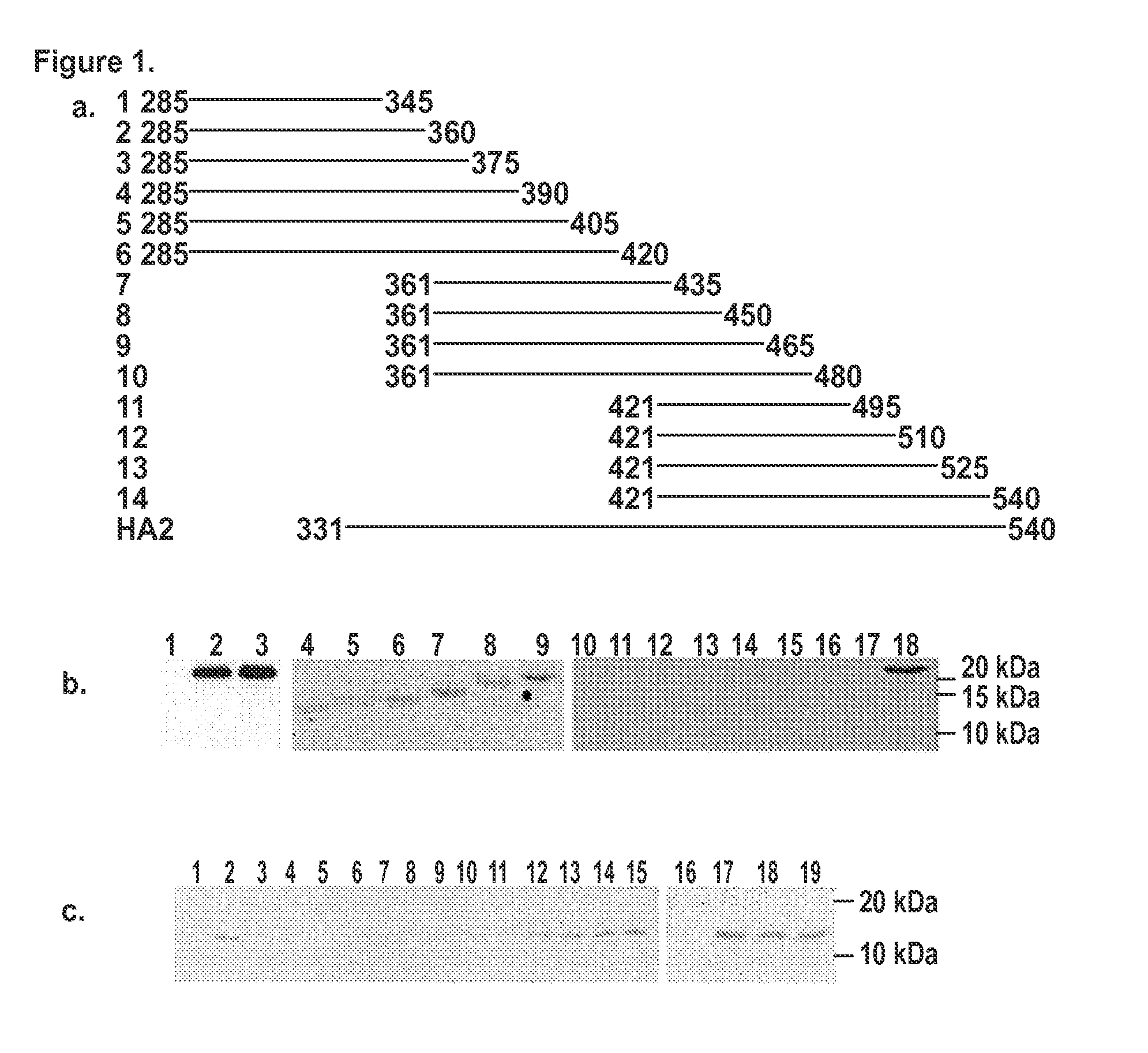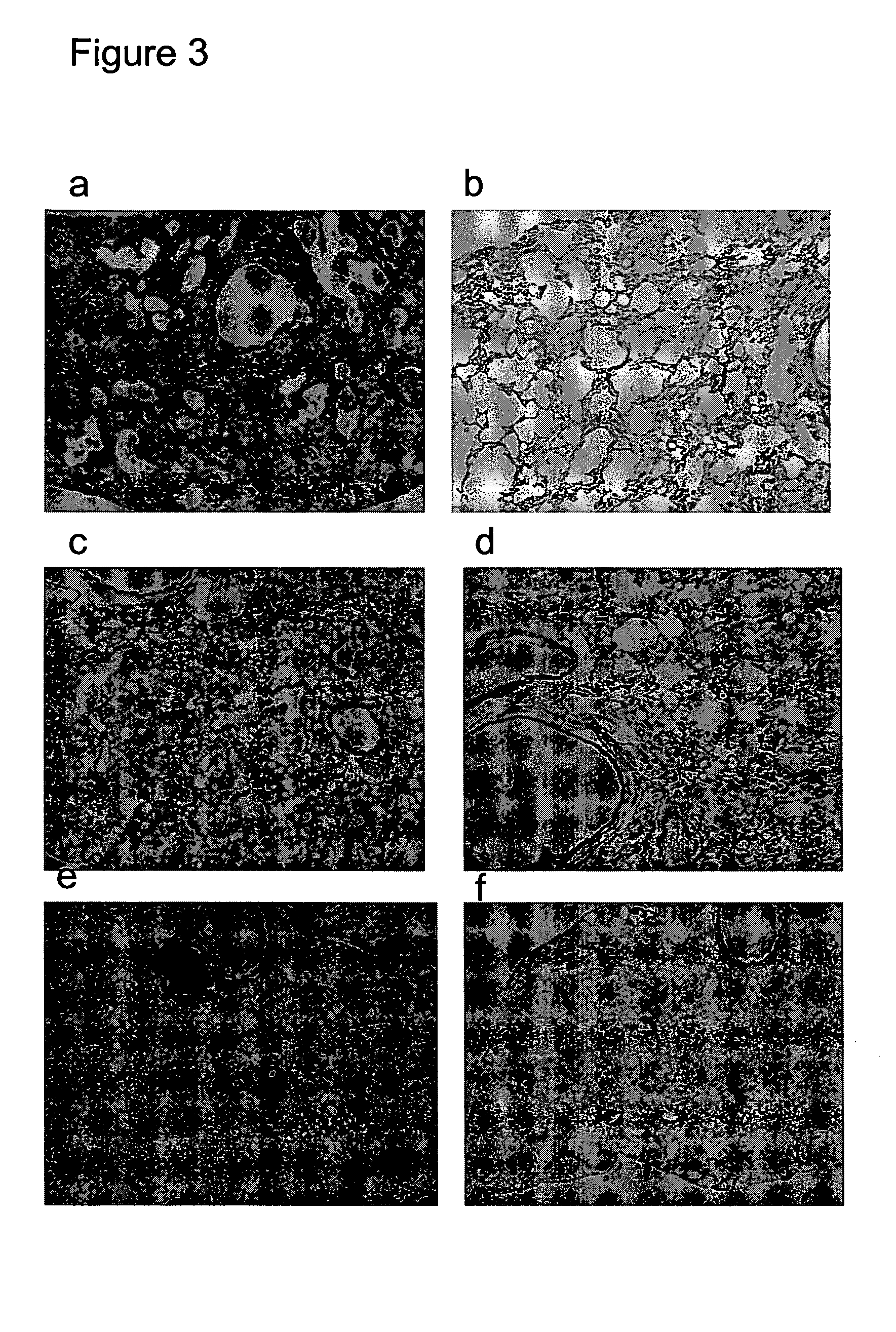Monoclonal antibodies specific to the fusion peptide from hemagglutinin from influenza A viruses and uses thereof
a technology of hemagglutinin and fusion peptide, which is applied in the field of monoclonal antibodies for the detection, prevention and treatment of influenza a virus infections, can solve the problems of imposing limitations on the current viral strategy, not being available in a timely manner to assist clinicians, and being less efficient against heterologous or mutant strains
- Summary
- Abstract
- Description
- Claims
- Application Information
AI Technical Summary
Benefits of technology
Problems solved by technology
Method used
Image
Examples
example 1
Production of Hybridomas
[0050]CHO-K1 cells and MDCK cells were obtained from American Type Culture Collection. They were cultured in Ham's F12-K medium and Dulbecco's Minimal Essential Medium respectively, both supplemented with 10% fetal bovine serum (FBS), 100 mg / ml streptomycin and 100 units penicillin, and maintained at 37° C., 5% CO2. Avian influenza virus H5N1 (A / goose / Guangdong / 97) was inactivated with betapropiolactone and used for RNA extraction to amplify the HA0 gene. The human HPAI H5N1 virus A / Indonesia / TLL013 / 06 was obtained from Ministry of Health (MOH), Indonesia. The clade 1.0 virus, A / Vietnam / 1203 / 2004 (H5N1) was rescued by reverse genetics. Briefly, the synthesized HA and NA genes were cloned into a dual-promoter plasmid for influenza A reverse genetics (16). Dual-promoter plasmids were obtained from the Center for Disease Control and Prevention, Atlanta, Ga., USA. The reassortant virus was rescued by transfecting plasmids containing HA and NA together with the re...
example 2
Screening of mAbs by IFA
[0054]Sf-9 and MDCK cells in 96-well plates were infected with recombinant baculovirus harboring the truncated H5N1 HA1 and HA0 gene, or with AIV H5N1 Indonesian strains, H5N2 and H5N3 strains, respectively. At 36 h (for Sf-9 cells) and 24-48 h (for MDCK cells) post-infection, the cells were fixed with 4% para-formaldehyde for 30 min at room temperature and washed thrice with PBS, pH 7.4. The fixed cells were incubated with hybridoma culture fluid at 37° C. for 1 h. Cells were rinsed thrice with PBS and incubated with a 1:40 dilution of fluorescein isothiocyanate (FITC)-conjugated rabbit anti-mouse Ig (Dako, Denmark). Cells were rinsed again in PBS, prior to scoring results in an epifluorescence microscope (Olympus, Japan) with appropriate barrier and excitation filters for optimized FITC visualization (21).
[0055]The monoclonal antibody 1C9, which was positive by IFA and immunoblotting, was chosen for epitope mapping. A total of 14 clones expressing fragments...
example 3
Screening Effect of mAbs on HA0 Conformational Change
[0056]The HA0 precursor of influenza A hemagglutinin was expressed on the surface of CHO-K1 cells. Upon treatment with trypsin and low pH, the HA0 undergoes a conformational change from the native to the fusion active form resulting in polykaryon formation. Normal polykaryon formation was observed in the control well. The formation of polykaryon was completely inhibited by mAb 1C9 at a concentration of 100 μg / ml and partially at a concentration of 50 μg / ml. An irrelevant monoclonal antibody 3H5 did not show any inhibition of polykaryon formation.
PUM
| Property | Measurement | Unit |
|---|---|---|
| volume | aaaaa | aaaaa |
| concentration | aaaaa | aaaaa |
| concentration | aaaaa | aaaaa |
Abstract
Description
Claims
Application Information
 Login to View More
Login to View More - R&D
- Intellectual Property
- Life Sciences
- Materials
- Tech Scout
- Unparalleled Data Quality
- Higher Quality Content
- 60% Fewer Hallucinations
Browse by: Latest US Patents, China's latest patents, Technical Efficacy Thesaurus, Application Domain, Technology Topic, Popular Technical Reports.
© 2025 PatSnap. All rights reserved.Legal|Privacy policy|Modern Slavery Act Transparency Statement|Sitemap|About US| Contact US: help@patsnap.com



